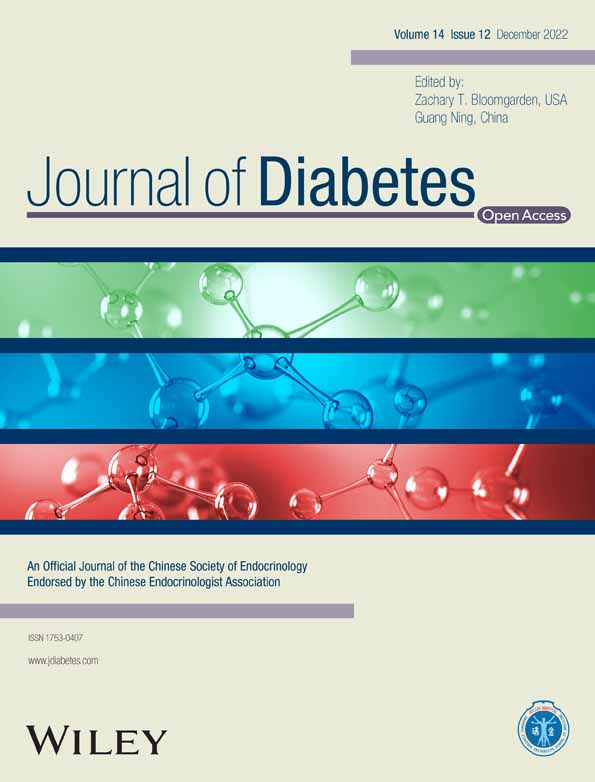Yogliptin monotherapy in type 2 diabetes: A 12-week randomized, double-blind, placebo-controlled phase II study
优格列汀单药治疗2型糖尿病:一项12周随机、双盲、安慰剂对照的II期研究
Xin Wang and Ying Wang are first authors.
Funding information: Easton Biopharmaceuticals; Scientific and technological project in Sichuan Province, Grant/Award Number: 2020YFS0459
Abstract
enBackground
The new xanthine dipeptidyl peptidase-4 inhibitor yogliptin has exhibited excellent hypoglycemic activity in experimental disease models. The present work aimed to assess the efficacy of yogliptin as a monotherapy in individuals with type 2 diabetes mellitus (T2DM).
Methods
A 12-week, double-blind, placebo-controlled phase II study was performed. T2DM patients (new diagnosis or inadequately controlled) were randomly divided into groups (1:1:1:1) and administered either a placebo or weekly doses of 200, 300, or 400 mg yogliptin, respectively. The primary efficacy end point in this analysis was hemoglobin A1c (HbA1c) change at 12 weeks relative to baseline. Relevant secondary outcomes were also examined, including fasting plasma glucose (FPG), 2 h-postprandial plasma glucose (PPG), body weight, and the rate of individuals who achieved the treatment goal of HbA1c ≤ 7% at 12 weeks from baseline.
Results
A total of 81 cases who received either the placebo (20 cases) or 200 (20 cases), 300 (20 cases), or 400 (21 cases) mg yogliptin were examined in the full analysis set. At 12 weeks, changes in HbA1c levels from baseline were 0.17 (−0.22, 0.57) in the placebo group, and −0.75 (−1.15, −0.35), −0.52 (−0.93, −0.11) and −1.02 (−1.41, −0.64) (mean % [95% confidence interval], p < .001 vs. placebo) in the 200, 300, and 400 mg yogliptin groups, respectively. From week four, significant improvements in secondary efficacy outcomes among patients administered the yogliptin monotherapy were observed. FPG showed markedly more pronounced reduction after treatment with yogliptin at 200, 300, and 400 mg in comparison with placebo patients at 4, 8, and 12 weeks. At 12 weeks, goal attainment (HbA1c ≤ 7%) was reached in 0%, 20.00%, 15.80%, and 33.33% of the placebo and three Yogliptin dosage groups, respectively. Adverse events were comparable in all groups.
Conclusions
This study demonstrated that yogliptin controlled glycemia in Chinese T2DM cases, with a great safety profile. The current findings supported that any of the three doses of yogliptin, administered once a week, could be used for phase III clinical studies.
摘要
zh背景与目的:新型DPP-4抑制剂优格列汀在实验性疾病模型中显示出良好的降糖活性。本研究旨在评估优格列汀单药治疗2型糖尿病(T2DM)的疗效。
方法:本研究为一项为期12周、双盲、安慰剂对照的II期研究。2型糖尿病(T2DM)患者(新诊断或血糖控制不佳)随机(1∶1∶1∶1)分组, 分别给予安慰剂或每周200、300或400 mg 优格列汀。此项分析的主要疗效终点是12周时HbA1c相对于基线的变化。同时检测了相关的次要结局指标, 包括FPG、2h-PPG、体重以及12周时HbA1c达标率(HbA1c≤7%)。
结果:共81例患者接受安慰剂(20例)、200 mg(20例)、300 mg(20例)和400 mg(21例)优格列汀治疗, 并进入全分析集(FAS)。12周时, 安慰剂组的HbA1c水平相对于基线的变化为0.17(-0.22,0.57), 200 mg、300 mg和400 mg 优格列汀组分别为-0.75(-1.15, -0.35)、-0.52(-0.93, -0.11)和-1.02(-1.41, -0.64)(中位% (95% CI), P<0.001 vs安慰剂)。从第4周开始, 接受优格列汀单药治疗的患者次要疗效结局有显著改善。在第4、8和12周时, 200 mg、300 mg和400 mg 优格列汀组的FPG下降幅度均显著高于安慰剂组。12周时, 安慰剂组和优格列汀3个剂量组的达标率(HbA1c≤7%)分别为0%、20.00%、15.80%和33.33%。各组的不良事件相当。
结论:优格列汀可有效控制中国2型糖尿病患者的血糖, 且安全性良好。目前的研究结果表明, 优格列汀每周给药1次的3种剂量中的任何一种均可用于III期临床研究。




